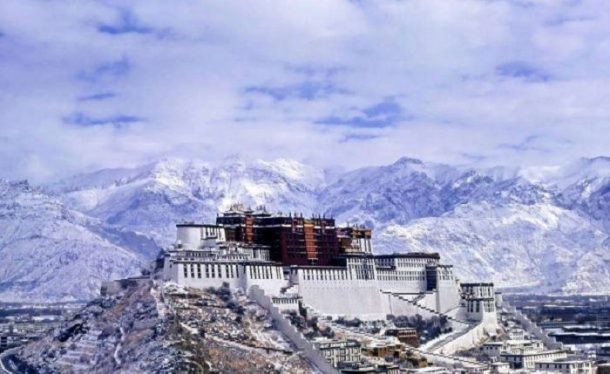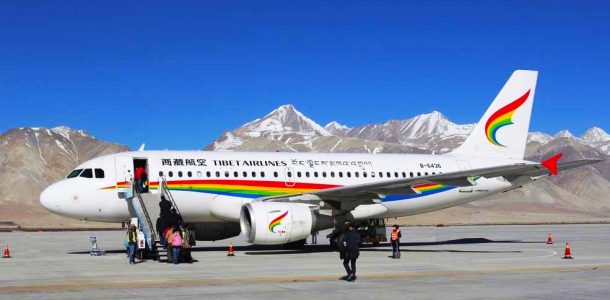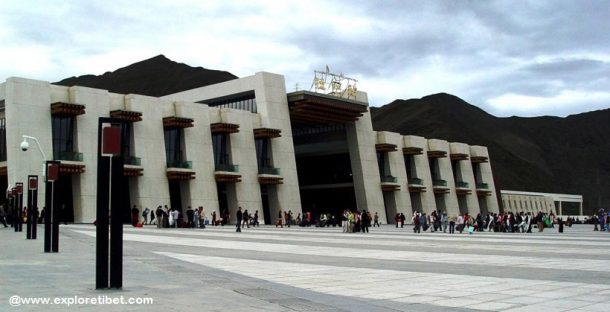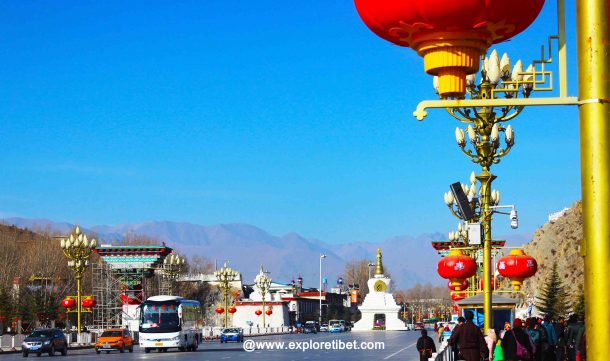A Complete Guide to Visiting Lhasa – Part 3
Table of Contents
How to travel to and around Lhasa
Known as the “City of Sunshine”, Lhasa is one of the most spectacular cities in the world. The world’s highest capital city is Lhasa. It is a mix of ancient and modern that melds together perfectly to give tourists and travelers the perfect Tibetan experience. The spiritual and cultural center of Tibet and Tibetan Buddhism. Lhasa lies at an altitude of 3,656 meters above sea level, in the stunning Lhasa Valley, on the banks of the Lhasa River, one of the major tributaries of the Yarlung Zangbo River.

A light dusting of snow coats the Potala Palace while the mountains behind are covered in thick snowfall
Traveling to Lhasa
Getting to the city for your Lhasa tour can be done in one of two ways, by flight and by train. Both of these travel options have their advantages and disadvantages, and the choice is entirely up to you. Flights can be taken from several cities across China, as well as from Kathmandu, while there are seven gateway cities to Tibet for the world-renowned Tibet Trains.
Flights
With more than a dozen different cities offering direct flights to Lhasa every day. You are spoilt for choice as to where to start your trip. However, there are certain locations from which it is usually preferable to get flights to Tibet. Kathmandu is one of the main options, and as the only international airport with direct flights to Lhasa, it is a popular choice. The flight is only 90 minutes long and passes directly over Mount Everest on the way to the Tibetan capital.
However, flights from Kathmandu can be a lot more expensive than from China. The requirement for permits is much greater, as you will need all of the permits for Tibet (with the exception of the Restricted Areas Permit).

Lhasa Gonggar Airport -Explore Tibet
Flights from several cities across China can be more favorable than flying from Kathmandu. So as the flights are often cheaper, although flights from Beijing and Shanghai can be just as expensive in the peak season.
The main airports for direct flights to Lhasa are from Beijing, Shanghai, Chengdu, Chongqing, Kunming, Xining, and Xi’an. Chengdu and Chongqing are the most popular when it comes to cost. As they have more discounted flights available than the other cities, though Xining and Kunming are the cheapest locations to fly from.
Chengdu, Xi’an, and Chongqing are also major international airline hubs, with flights from several locations across Europe landing there. And with flights taking from 2-4 hours, it is a fast trip to the Tibetan capital.
Trains
Fast becoming the more popular option, as more people head to Tibet for the Small Group Tours, which make the whole trip much cheaper now than it ever has before. The trains to Tibet are an amazing adventure of discovery.
Trains are much more comfortable than flights, with a choice of three ticket classes; Hard Seat, Hard Sleeper, and Soft Sleeper. However, the Hard Seats are not recommended considering the length of the train journeys.

Lhasa Railway Station, to the south of the Lhasa River
Trains leave for Tibet from Guangzhou, Beijing, Shanghai, Chengdu, Chongqing, Lanzhou, and Xining, and travel thousands of kilometers to get to Lhasa. All trains to Lhasa pass through the Qinghai city of Xining.
The closest of the departure locations is Xining, and then head up to the Kunlun and Tanggula Mountain ranges, where they cross the boundary into Tibet Autonomous Region. Then it is down across the vast Tibetan plateau to Lhasa.
The trip is a spectacular tour of the northeastern area of Tibet, running through places that you would not normally see on a regular tour of Tibet. It makes the whole trip worthwhile. However, with travel times ranging from 22 hours to 55 hours, it is not the ideal travel method if you are pushed for time.
Traveling around Lhasa
If your tour is going to be in the area of Lhasa only, then you are not going to need all the permits that are required for tours outside the area of the Tibetan capital. Travel in Tibet is restricted, and international tourists are not permitted to travel around alone using public transport, except in the city of Lhasa.
Outside Lhasa, you need to have a guide and private vehicle to travel around the region. But while you are in Lhasa itself, public transport can be used. As long as you remain within the city limits. Your guide can give you exact details of where you are permitted to travel to on the local means of transport.

Lhasa City, Tibetan Autonomous Region-Explore Tibet
Taxi
While taxis in many capital cities are expensive, especially for tourists. But in Lhasa, It is relatively cheap, with fares starting at around 5 yuan for the first five kilometers. After that, you will pay around 1.5 yuan per kilometer. An average trip to most places in the city from the downtown area should cost around 10 yuan, which is about a dollar-fifty.
The fare to Drepung Monastery is around 20 yuan, or three dollars, while Sera is about 15 yuan. If you want to splurge. You can hire the taxis for the whole day for around 200-300 yuan, or 30-45 dollars. The taxis are easily recognizable and can be flagged down the same way you would at home.
Public Buses
The cheapest option for traveling around Lhasa is the public buses. There are around 20 routes across the city. Including routes that take them to the railway station, the only trip outside the city you can take.
However, the bus stops can be a little hard to find, and the information signs at the stops often only list the major stops. The routes are also only in Chinese and Tibetan, so you may have a bit of an issue knowing which bus you want.
A little research and advice from your guide would help with getting the right bus. Fares are cheap, with most of the routes costing jus t1-2 yuan for the whole fare. Buses also tend to run at 20-minute intervals, so there are always plenty more if you miss the one you wanted.
Pedicabs or rickshaws
The typical Asian man-powered taxi can also be found in Lhasa, and these two-passenger pedicabs can be found all over the city. They only run within the city limits. So you cannot make the mistake of getting the wrong one that goes out of the city.
They make a great way to travel around and see some of the more obscure sights of this stunning city. You can flag them down the same way you would a taxi. You can get an amazing view of the city from the open cab as you pass along the city streets.
Trips normally cost from three to seven yuan for the pedicab. It is advisable to discuss the route you want to take and agree on a price before getting in. While it may seem like a cheap way to tour the city. You should remember that these are all run by local Tibetans. You are helping them to have a better income by using them instead of taxis and buses. Besides, there is no better way to tour the city than in your own open-fronted rickshaw.
Recent Posts
Tibet Travel Cost Breakdown: Budget vs Luxury Options
Trekking the Himalayas: Best Adventure Tours in Tibet
An Adventurer’s Guide to Tibet’s Wild Landscapes
All Categories
- About Tibet
- book a Tibet tour
- Buddhism Practice
- Budget Tour
- China-Tibet Train
- Customized Tibet tour
- Historical Sites
- Hot Springs in Tibet
- News
- Photography in Tibet
- Tibet attraction
- Tibet Group Visa
- Tibet Motorcycle Tour
- Tibet Small Group Tours
- Tibet Tours and Tibetan Tour Guide
- Tibet Train
- Tibet Travel FAQs
- Tibet Travel Information
- Tibet Travel News
- Tibet Travel Permit Update
- Tibet Travel Prices Rises
- Tibet Trek
- Tibet Trekking Tour
- Tibet weather and climate
- Tibet Wildlife animals
- Tibet Winter Tour
- Tibetan Buddhism
- Tibetan Cultural Features
- Tibetan Culture and Poeple
- Tibetan Festivals
- What to see in Tibet



